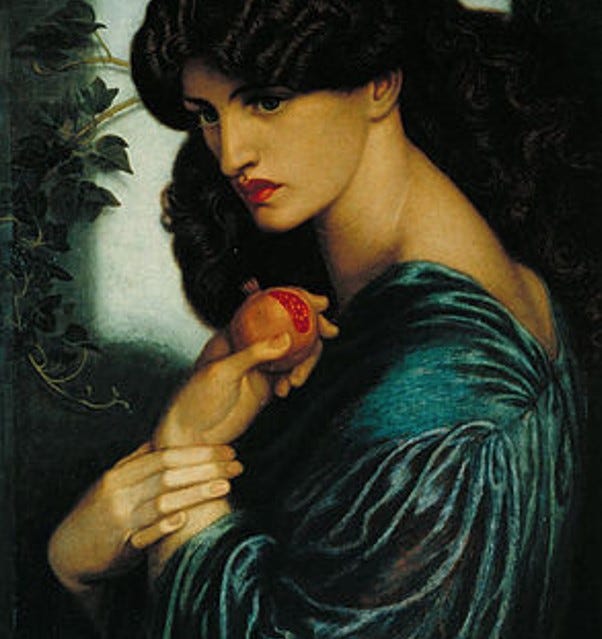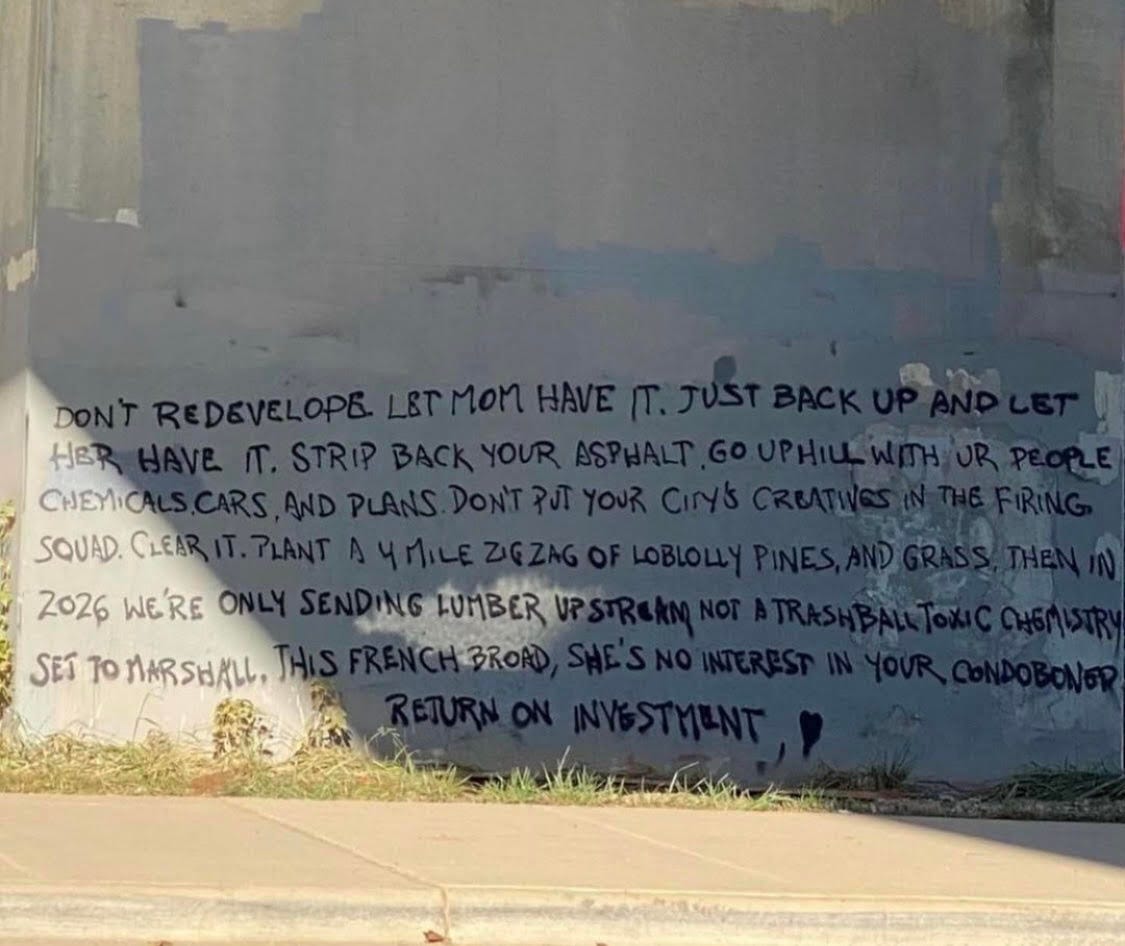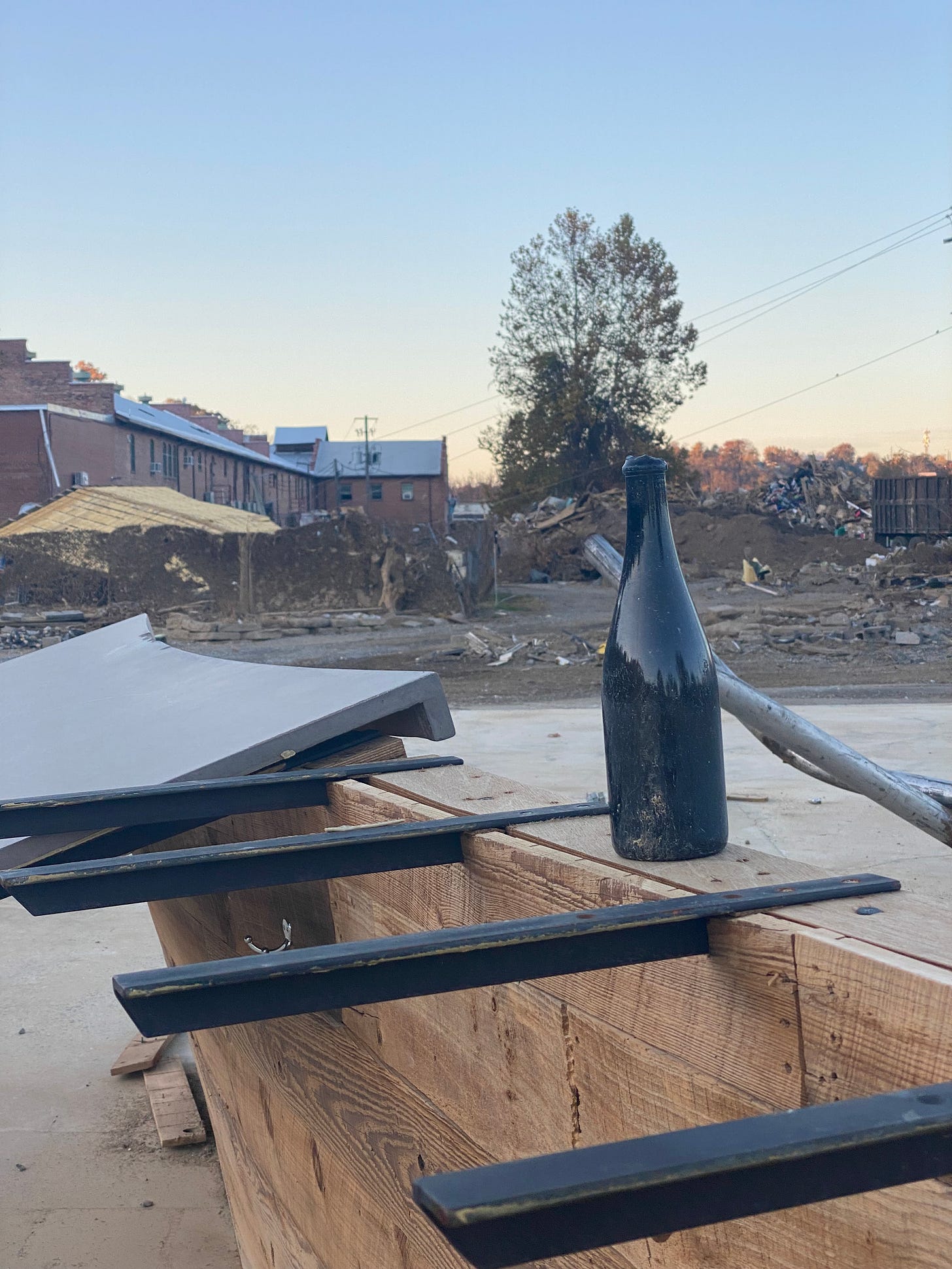
*note: apologies if this got sent to anyone twice… dealing with some tech things but figuring them out! ❤️🔥
Dear Shapeshifters,
Things feel confused.
The leaves are changing colors but the days are hotter than usual, even as they grow shorter.
Where do we root ourselves in time and place when the seasons themselves shapeshift, when the ground beneath us falls away?
Or in the differently disorienting experience of somehow having ground beneath us, but being painfully aware of it’s precarity, perhaps even crossing the threshold of destruction and stability several times a day? Whether that realm straddling be through our screens, our relationships, or across our bioregions?
While my house is fine…. 75% or more of the places I love here in Asheville have been destroyed. Gone. And simultaneously, I can drive on a bridge over the obliterated river arts district to a well stocked whole foods. Meanwhile, many, many people are still without power or roads to their homes, many people’s workplaces and homes have completely washed away.
But, still, I find poetry on the walls:

Still, I can hear the rustling of the trees and smell the richness of fallen leaves.
Still, I can find people tending to the most broken of places, as I encounter artfully placed objects in buildings that no longer exist.
And still, people are showing up for one another in decentralized mutual aid efforts across the region.
This is where we root.
This poetry, this creative daring, this miraculous persistence of life, human and more than, this, each of us figuring out how to literally and metaphorically feed each other.
Our stories, our communities, and our creative practices can be our touchstones when everything else stops making sense.
Amidst the disorientation of massive grief, the destruction of landscapes and our lives as we have known them, a striking sense of clarity can arise.
When we are lost, our senses heighten to take in our surroundings. We pay more attention to the beings around us. We get present.
I was reminded of Grace Lee Boggs’ question: “What time is it on the clock of the world?” when listening to adrienne maree brown’s conversation with Vanessa German on How to Survive the End of the World, in which adrienne maree brown shared the question she is rooting and finding a sense of orientation in:
“What is the mundane, miraculous stuff I’m gonna do with other people that I can put my hands on and my eyes on and my attention on to try to make a way forward?”
And I’m thinking about Vanessa German’s response and recognition of “how radical it is to situate yourself within the living recognition of the miraculous… which is in and of itself an answer...”
“so I recognize that the time on the clock of the world is that time… to be like, I'm here, I am here, I am here. I am constantly crossing these thresholds. And I'm in a universe where the miraculous is possible…
…you are saying in the deepest, truest way, I am not alone. We are not alone. And it's that time. That's the time.”
Scorpio Season & the Miracle of Water
This hurricane portal season has me thinking a LOT about water and grief.
Water is our first home. We grow in a watery womb and come into this world through water breaking. Water sustains all life, and it can simultaneously destroy it. We are intimately familiar with water, and yet the ocean makes us feel small, in awe of its unknown and unfamiliar realms. Hurricane Helene has made me aware of not only the devastating power of water, but it’s preciousness, as it’s been just over a month since we’ve had running potable water.
And grief often reveals to us the ways we are water: it draws it out of us, it draws us to it, it reveals to us our shared shapeshifting and multidimensional nature. We see storms, thrashing waters and we relate, we find peace in calming waters, renewal in submerging ourselves in bodies of water. We cry salt water. We experience our emotions, memory, imagination in the metaphors of water: we melt, we get flooded, we freeze, we swim, we drink in, we flow, we channel, emotions cascade and roll and crash like waves. We remember, again and again, the ways we are water.
The season of Scorpio, a water sign, offers particular reflections for us on thresholds, water, and liminality. We are invited to dive into the portals of the unknown and our subconscious, to deepen our intuitive and magical practices, our sense of the miraculous and preciousness of life.
I’ve been coming back to Aurora Levins Morales’ and Dori Midnight’s poem “Handwashing” in Aurora’s book Rimonim. Here’s a piece of it:
“Wash your hands like its the gush of water from a womb and someone we will love forever is about to be born.
and this water we pour has danced round our planet since the very first molecules came hurtling out of the sky, clinging to celestial rock
and this water has passed in and out of all our generations, charged with memory, so that we pour the stories of a billion years across our palms…”
Samhain
Samhain is the Gaelic celebration of thresholds and liminality, a festival marking the transition to the darker half of the year, a festival of the dead. It’s said not only the spirits of the dead but all manner of supernatural beings could move more easily between our world and the Otherworld during this time. Ancient burial grounds were opened, divination using nuts and apples was practiced, feasts and bonfires were had, costumes and disguises were worn as people traveled around their neighborhoods trading verses for food, and the dead were set a place at the table.
The festivals of death at this time of year remind us that our grief and our joy are woven together. These are festivals after all, where we are invited to pour libations, celebrate the liminal, our dead, and our undying connections to them.
And grief itself is an altared, liminal state, in which we may experience not just sorrow but an impossibility of ignoring the sacred and the magic of being alive at all.
So a festival honoring our dead feels right on time in this hurricane polycrisis portal. How do we want to greet the dark?
In Scorpio season, the unknown extends a hand, and asks us to dance.
Inspiration for Making Kin & Feeding the Miraculous in the Underworld: Persephone, the Death Card, and Pomegranate
I always like to choose some anchors or inspiration for each season. Sometimes they are ideas, sometimes tarot cards, sometimes plants. For Samhain, I’m choosing Persephone, the Death card, and Pomegranate.
Persephone
Persephone, the daughter of Demeter, Greek Goddess of grain and agriculture, is no longer on the brink of her descent, she is on her way down, returning to her reign as Queen of the Underworld.
While Demeter grieves, what is Persephone’s experience? Her exile is also a return to her reign as Queen. I imagine she feels many things—grief among them. But a child’s grief is different than a parent with an empty nest. Does Persephone feel relief at having time away from her mother? Is she getting some rest and solitude down there? Or is she greeted by a colorful circle of freaks and monsters that have become her chosen family? Or a mixture of all the above? I like to imagine that Persephone leans into agency and community where she has it, rather than spending the entire winter in despair or simply trying to claw her way out of the underworld alone.
Rather than simply returning to the surface, the chthonic Persephone mixes and troubles, must belong to both realms and must move between the familiar and the unknown, unsettling and troubling the tidiness of borders. She carries the underworld with her into the green world. She carries the green world with her into the underworld. In her cycles of descent and return, Persephone “make[s] and unmake[s],” and is “made and unmade” (Haraway).
I’ve been considering Rebecca Solnit’s work this season as I think about underworlds and the stories we tell about them, and what it means to be living in an underworld and trying to make life there. How might we reconceive Persephone’s descent in the face of climate chaos, as descent not only into fall, but a time of increasingly destructive hurricanes and climate chaos?
In her book, A Paradise in Hell: The Extraordinary Communities that Arise in Disaster, Solnit shares:
“If paradise now arises in hell, it’s because in the suspension of the usual order and the failure of most systems, we are free to live and act another way.”
Persephone’s descent this Fall reminds me that being with death and the precarity of life, can, while terrifying, truly invite us to live. When we have nothing left but each other and our wild dreaming, we can finally cast aside that which keeps us tethered to oppressive systems. Their grasp loosens. We get to choose something else.
Within this underworld, there is a vast and deep well to draw from, a capacity to make magic and care for one another, to truly come alive.
The Death Card
Death is a shapeshifter.
And our depictions of death shapeshift across place and time. So the death card, like all of the cards has shapeshifted overtime.
We have a spectacle of death today – with an ongoing pandemic, multiple ongoing genocides and cop cities and militarism being the ways that we see many governments responding to the crises of climate change that they are also actively perpetuating.
The death card invites us to really drop into what matters most in this life. How do we want to live? How do we want to die?
The Death card invites us to expand our sense of self, our sense of who “us” is, to surrender our individualism. Death asks us how we want to meet our fear, and invites us to be brave.
As someone deeply inspired by death care work and being with grief, I am interested in what happens when instead of buying into the spectacle of death, in which we are conditioned into a role of a kind of helpless and fearful spectator – what happens when we engage with it, when we cultivate collective capacity to be with fear and to be brave together and instead of arming ourselves against death and one another? What happens when we link up?
Christopher Marmolejo shares in Red Tarot: A Decolonial Guide to Divinatory Practice:
“Death reawakens the collective body, reminding us we have a part in sustaining the heart of our love beyond the corporeal…Death is the process of collectivization...”
While death might remind us how precarious and fragile life is, death also extends to us the opportunity to remember our own strength in the face of that precarity, and our capacity for endless transformation, which, however frightening, is the stuff we are made of.
Pomegranate Magic
I like thinking of Pomegranate as a kind of delicious mirror to the death card, one that brings us into our bodies.
In Persephone’s story, Pomegranate plays the role of both the trick and the glittering irresistible treat. When Persephone was finally allowed to reunite with her mother, she is tricked by Hades into eating the seeds of a pomegranate, which prevent her from leaving for good. And so Persephone is allowed to return to the world above, on the condition that she returns for the other half of the year.
I like to imagine though that maybe Persephone chose to eat the pomegranate, because she wanted to. And maybe she chose to stay in the underworld rather than escape its reality.
Perhaps pomegranate invites us to lean in as we come undone, to make allies in this underworld, to not simply seek to return, but to unsettle ourselves and borders through cyclical descent to a “rugged land that’s hard to colonize” (Josh Shrei), to find new ways “to live and die well with each other in a thick present… to stir up potent response to devastating events, as well as to settle troubled waters and rebuild quiet places” (Donna Haraway, Staying with the Trouble).
Donna Haraway reminds us that our making of kin makes trouble for oppressive systems, that the word trouble itself comes from “a thirteenth-century French verb meaning ‘to stir up,’ ‘to make cloudy,’ ‘to disturb.’”
Perhaps Pomegranate invites us to stir shit up with our capacity to make kin, to stay with the trouble, to be altared by the grief of our times.
There is also something about opening a Pomegranate that fills me with a deep sense of wonder and possibility, as if the glittering, ruby filled fruit says, ‘many worlds are possible!’
And as a fruit of the dead, pomegranate invites us to live. If we live in deep acknowledgment of how precarious and fleeting life is, we learn to savor pleasure and honor the deepest longings of these bodies of ours.
What possibilities might open when we turn towards that which we’ve told ourselves is not possible? Even at the micro level, such as allowing ourselves to explore an art medium or practice that feels like a forbidden fruit to us? How might our ability to taste these forbidden fruits help us remember our power, respond to collective grief, and stay with the trouble of our times? How this might feed our creative lives and allow our dreaming to run freely?
What does it look like to stretch ourselves across realms, to taste the forbidden fruits of our own creative desires and dreaming, even and especially within an underworld of grief?
A Grief Spell for Being Stretched
a collaboration with
May our longing stretch us across continents and realms Not like a canvas but something that sings a migration the rain a story a plucked string Let us linger here In the moments when we are made unsteady with song, let us listen for who sings with us and who sings us Let us linger here in the places where we are caught in our falling Like drops of rain suspended on a spiderweb Not knowing yet what it’s like to be tasted by soil Knowing only the feeling of being Pulled and held Let us learn the art of dwelling here and there, and not there yet and Let us swell Make us holy With the gravity of each other Without the promise of arrival As the ocean and moon breathe restraint and desire With each orbit and tide Stretched and full May we be remade each day less linear and more cyclical less rigid and more fluid as lovers as movers between realms of space and time
Announcing Upcoming Courses!
Herbalism for Grief Support & Staying with the Trouble
Herbalism for Grief Support is back and getting revamped. This cohort will include workshops with our incredible guest instructors such as Damiana Calvario, dori midnight, and Rebecca Beyer. A 4 month introductory herbalism course exploring plant allies, herbal rituals, and remedies for supporting ourselves through grief and trauma, and ways we can partner with plants as we stay with the trouble & build networks of community care in times of big grief.
Begins January 2025!
Tears of the Gods: Flowers, Grief, Death, & Shapeshifting
A 6 month course exploring folklore and myths of flowers and plants as they relate to death, grief, and shapeshifting, in which participants are invited to explore, create, and share their own plant inspired stories, crafts, art pieces, and reflections. A course for those wanting to make art in collaboration with plants and their folklore, but not necessarily focus on the herbal medicine piece.
Begins January 2025!
Subscribe to Grief Spells
Your subscriptions help support my work and help us skirt the whims of the algorithm! As of right now, all subscription tiers (including free) will receive access to seasonal grief spells, and any other writing I share in between.
You can also support my writing by becoming a paid subscriber to this newsletter for $16-20/month 💖 Your paid subscriptions help me so that I don't have to spend as much time marketing, and can instead focus on creating and doing what I love. THANK YOU!
Paid subscribers will also get access to live community events each season. These Grief Studios will be spaces to dialogue with, make, and share your own art and writing alongside other grievers. 🕸️





I love that you take the view Persephone reinvented herself and thrives in her otherworld existence. Too many people lately have interpreted her as victim of patriarchy or symbolic of drawing inwards at the dark half; seeing her come alive where she’s not believed to is very inspiring.